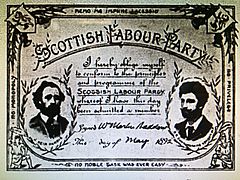Scottish Labour Party (1888) facts for kids
Quick facts for kids
Scottish Labour Party
|
|
|---|---|
 |
|
| President | Robert Bontine Cunninghame Graham |
| Secretary-General | Keir Hardie |
| Founder | Robert Bontine Cunninghame Graham Keir Hardie |
| Founded | 25 August 1888 |
| Dissolved | 1895 |
| Merged into | Independent Labour Party |
| Ideology | Socialism Nationalisation Home rule |
| Political position | Left-wing |
| Slogan | No Noble Task Was Ever Easy |
The Scottish Labour Party (SLP) was a political group in Scotland. It was started by two important people: Robert Bontine Cunninghame Graham and Keir Hardie. Robert Graham was the very first Member of Parliament (MP) in the UK who believed in socialism. He later helped start the Scottish National Party. Keir Hardie became the first leader of the Independent Labour Party and the main Labour Party in the UK.
Contents
The Party's Beginning
The Scottish Labour Party started because Keir Hardie tried to become an MP in 1888 but didn't win. He wanted the Liberal Party to support him, but they didn't. This made many miners, who were his friends, realize they needed their own political party. They wanted a party that would truly represent the interests of working people.
Some radical thinkers also liked this idea. The Dundee Radical Association supported Hardie's movement. Many early members, including Hardie, had been part of the Scottish Land Restoration League, which worked for land reform.
Founding Meeting
A first meeting was held in Glasgow in May 1888. The official founding conference happened on August 25. Robert Bontine Cunninghame Graham led this meeting. Other people there included John Ferguson, John Murdoch, Shaw Maxwell, and Robert Smillie.
At first, other socialist groups like the Social Democratic Federation didn't join. But the different groups at the meeting agreed on a plan for the party. This plan was mostly based on ideas from Keir Hardie. Hardie became the party's Secretary, and Graham was the President.
Party Challenges
Robert Bontine Cunninghame Graham was the party's main MP. He represented the North West Lanarkshire area. He had left the Liberal Party in 1888. He lost his seat in the 1892 general election.
Two other MPs, Gavin Clark and Charles Conybeare, were also involved with the party until 1893. After they left, the party decided it was fully in favor of socialism. They also said that party officials could not be members of other political parties at the same time.
Election Attempts
The Scottish Labour Party tried to get more MPs elected in 1892. They had two other candidates: J. Bennett Burleigh and James MacDonald. Robert Graham and Shaw Maxwell tried to make a deal with the Liberal Party so they wouldn't compete against each other, but it didn't work. The SLP candidates did not get many votes in that election.
The Party Ends
The Scottish Labour Party first supported a movement by Henry Hyde Champion that worked with local trade unions. But they became worried when this movement started its own party, the Scottish United Trades Councils Labour Party. This new party seemed like it might compete with the Scottish Labour Party.
However, Champion's movement didn't last long. But it did help some trade unions decide to support independent candidates for working people. This led to closer teamwork with the Scottish Labour Party.
Joining the ILP
In 1894, Keir Hardie became the President of a new party called the Independent Labour Party (ILP). Most members of the Scottish Labour Party supported him. So, in early 1895, the Scottish Labour Party officially joined and became part of the ILP.
Election Results
1892 UK General Election
| Constituency | Candidate | Votes | Percentage | Position |
|---|---|---|---|---|
| Dundee | James MacDonald | 354 | 1.3 | 5 |
| Glasgow Camlachie | Robert Cunninghame-Graham | 906 | 11.9 | 3 |
| Glasgow Tradeston | Bennet Burleigh | 783 | 10.7 | 3 |

